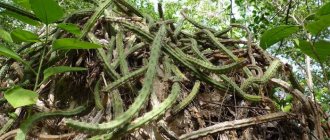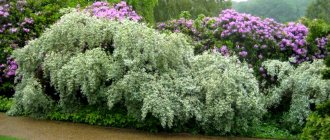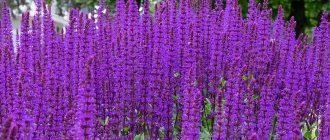Japanese crimson is an ornamental plant that can become a decoration in various landscape structures. It blooms at the beginning of spring, when nature is just beginning to awaken after a long winter hibernation, and with its bright colors and pleasant smell it attracts the close attention of others. As the name suggests, this type of scarlet is native to Japan. The plant is widespread in China, and has recently been gaining popularity in our country.
Description of crimson
In its native habitat, the tree often grows as a giant, reaching almost 30 meters in height with a trunk girth of 5-6 meters. Of course, in central Russia the plant will be much smaller, up to 4-7 m in height, but this is enough for the Japanese crimson to gain popularity in the Moscow region for its beauty and not too demanding attitude to living conditions and care.
The plant's appearance resembles a shrub, having not one, but many trunks, forming a cone-shaped crown. The tree bark, riddled with cracks, together with heart-shaped leaves with an unusual shade of crimson or reddish color, gives the plant an amazing, exotic decorative appearance. The newly emerging soft pink foliage begins to darken over time, becoming golden sandy in the fall. The reddish and crimson veins clearly visible on the leaves give them additional charm.
During the flowering period, the plant also looks stunning. Bright purple flowers with a pinkish tint cover the branches, forming continuous inflorescences when the leaves are not yet on the tree. The delicate aroma of vanilla surrounds the flowering plant , adding to its attractiveness. Therefore, the scarlet plant is increasingly becoming a welcome guest in garden plots and park recreation areas.
Although the tree comes from warm countries with a subtropical climate, not every southern plant feels as good as the Japanese crimson in central Russia. The winter hardiness of the plant is such that it can withstand low temperatures, up to 30 degrees below zero. Of course, young seedlings require more careful care than mature trees, including shelter from the winter cold. However, a patient gardener is able to overcome the difficulties that arise in growing this exotic plant and plant this outlandish beauty in his garden.
Reasons for the rare use of wood in Russia
It should be noted that despite its spectacular and original coloring, this tree is quite rarely used in our latitudes.
The main reasons for this include the fact that the natural habitat of this plant is sunny subtropics.
That is why remember that if you decide to make the Japanese crimson plant the main “highlight” of your garden, the tree should be cared for with special care and painstaking care.
Also, the reasons why Japanese scarlet is rarely used in gardening include the ignorance of many amateur gardeners of the basic rules for planting and caring for this plant.
And of course, Japanese scarlet is a rather exotic plant that can be bought exclusively in specialized nurseries.
Difficulties in purchasing a plant contribute to the fact that many gardening fans simply refuse to grow it.
Planting and caring for the plant
The most preferable place to plant crimson will be a sunny area with good drainage and fertile soil. Partial shade will not be an obstacle to normal plant growth.
Planting crimson
When choosing a planting site, it should be taken into account that it is unlikely that the tree will be replanted due to the characteristics of the plant’s root system, which has a core structure with a small number of underdeveloped lateral roots. It is recommended to plant seedlings together with a lump of earth, using the transshipment method as a gentle method of replanting plants. Simple recommendations when planting crimson:
- Prepare the hole in advance by fertilizing it with compost or humus.
- When planting, the root collar should remain at the same level as before.
- Place the seedling vertically, cover it with soil and lightly compact the soil.
- Water generously at the root at the rate of: a bucket of water for each seedling.
After planting, it is necessary to monitor the condition of the soil, preventing it from drying out, which will allow the plant to quickly take root and begin to grow.
Watering and fertilizing
Japanese crimson is a very moisture-loving plant. During long periods of drought and hot weather, it may lose its leaf cover due to lack of moisture in the soil. Therefore, regular watering with a well-wetted area of soil adjacent to the trunk zone should become the rule necessary for the normal development of the tree. By using mulching as a way to protect roots from overheating and moisture retention, you can also improve soil structure by providing air and water access to the plant's root system.
Fertilizing is necessary only for young plants that are growing green mass. It is advisable to use fertilizers that have a low nitrogen content, otherwise you can achieve the opposite effect when actively growing young branches do not have time to ripen before the onset of winter and die under the influence of cold weather.
Top dressing is applied in spring and early summer, every two weeks. Then the application of fertilizers is stopped so that the branches have time to become lignified. This way the plant will be better prepared for the winter cold.
Features of flowering and pruning
The scarlet blossoms, although beautiful, do not last long, only a week, but this should not upset gardeners, because the plant immediately acquires leaves no less beautiful than the flowers themselves. If frost returns, young branches may freeze slightly , but with the return of warmth they quickly recover.
Trim the plant in early spring, before sap flow begins. If the purpose of pruning is not to give the plant a curly shape, then only branches that thicken the crown, that are frozen and damaged by pests should be removed. To form intricate figures, trimming is done at your own discretion.
Propagation of crimson
Gardeners who decide to grow Japanese crimson on their property have a question: how to independently increase the number of plants? There are two main ways to propagate Japanese scarlet - by cuttings and seeds.
Reproduction by cuttings
The most acceptable and simplest way to propagate scarlet is by cuttings. At the beginning of summer, young green branches are cut and placed in water, damp sand or a special nutritious soil mixture. To improve the root formation process, you can first soak the cuttings in a solution of root or heteroauxin. Then the future seedlings are covered to create a greenhouse effect with high humidity, using polyethylene or glass. After a month, young shoots will begin to grow on the cuttings, which is a sign of successful rooting.
Use of seeds
Seed collection is carried out from late September to early October. The collected seed material is immediately sown in a seedling box to a depth of about 2 cm, placed in the garden and covered with leaves.
Thus, the seeds are kept at low temperatures to accelerate their germination (stratification). The same procedure can be carried out in the refrigerator by placing the seeds on a damp cloth and wrapping them in a plastic bag. Thus, in spring the germination rate can reach 75% . With the onset of spring (in March), a box of seeds is brought into the house or taken out of the refrigerator.
Further germination is carried out indoors with systematic watering. The emerging seedlings develop slowly, so you should be patient. When two or three true leaves appear on them, the young plants are transplanted into separate pots, as in the case of cuttings, carefully moving them along with a lump of earth so as not to damage the root system. The growing process will take place there.
With the onset of autumn, young seedlings can be carefully planted in a permanent place. It is necessary to cover the plants with spruce branches or leaves for the winter in order to protect the still fragile seedlings from the winter cold.
Some gardeners do not risk planting plants before winter, preferring to postpone planting to the next season, to spring.
How to choose planting material
Garden nurseries say that seed collected independently cannot produce new plants. As practice shows, if the stratification conditions are met, you can grow a tree at home.
In official representative offices, Japanese scarlet 170 cm high can be purchased at a price of 5,690 rubles. A package of Japanese scarlet seeds (5 pieces) is sold for 150 rubles.
Often in garden centers they sell the Cercis plant, which has a low winter hardiness threshold, under the guise of “crimson plant”. Cercis leaves look like crimson. Cercidiphyllum can be recognized by the opposite arrangement of foliage. In Cercis, the vegetative organs are formed alternately.
The crimson tree is difficult to tolerate transplantation. Therefore, it is advisable to choose seedlings planted in a container. Buyers often complain about nurseries being deceived. On one tree, leaves of different shades (yellow, green and crimson) can actually form at the same time. But autumn color directly depends on the quality of the substrate and microclimatic conditions.
A variety called Pendula
One of the interesting forms of this plant species is the Japanese crimson Pendula. It also has another name - weeping tree. The crown of the plant has a look reminiscent of our weeping willow, which was the reason for its name. Pendula's appearance:
- The height of the tree reaches 4−6 m.
- The leaves are large, up to 10 cm, bloom red, then turn green. In autumn - yellow, orange and bright red.
- The bark is dark gray, covered with cracks.
- The flowers are small and pale. (from April to May).
- The fruits are bright, red, up to 1 cm in diameter, ripen in September.
The tree prefers fertile soils and is resistant to drought. The beauty and specific shape of the crown of the Japanese pendula make it possible to use it in landscape design for arranging free-growing hedges, as well as for landscaping parks and streets. The plant looks very harmonious on the banks of artificial or natural reservoirs.
Japanese crimson: colorful and fragrant leaves
We all understand how important the visual beauty of a garden is. Plants can be as healthy, rare and useful as you like, if they are not pleasing to the eye, the effect will not be the same. And for some reason, the words “visual beauty” bring to mind first of all beautiful flowers or a lawn of emerald grass dotted with them. However, you must agree that plants of a completely different, but no less beautiful, immediately come to mind: variegated grasses, serious conifers, creeping ground covers - and of course graceful deciduous trees. For example, scarlet.
Japanese crimson (Cercidiophyllum japonicum) is an oriental plant that has spread to gardens around the world from China and Japan. The name itself indicates that the scarlet has “leaves like cercis” - and it is really confused with cercis (Cercis siliquastrum, for example)! But these plants are completely unrelated to each other: Cercis belongs to the legume family (Fabaceae) and is valued for its wonderful pink flowers. And our crimson comes from the family of the same name (Cercidiphyllacea) and is loved by everyone for its beautiful foliage color and crown shape.
Interesting features
Crimson is a very interesting plant. In addition to its outlandish beauty, it has other interesting features:
- The plant retains a caramel aroma from flowering until late autumn, which is why it is often called the “gingerbread” tree.
- Bud flowers can form not only in the axils of the leaves, but also on the trunk and large branches.
- Crimson can also be grown at home, preferably in a wooden tub. To support the dwarf shape of an indoor tree, you should trim and shorten the side shoots in a timely manner. Using the bonsai technique, you can grow a miniature specimen of this Japanese plant.
- Japanese pharmacies sell scarlet bark (katsura), which has healing properties.
- Katsura wood is a wonderful textured material, light brown on the outside with a red-brown core. It is used for interior decoration and furniture making. Masters of artistic wood carving are happy to choose it as the initial basis for their works.
- Crimson can cause allergic reactions in some people who cannot tolerate its vanilla scent.
If symptoms of allergic reactions occur, it is recommended to limit contact with the plant, and carry out all work with the tree using protective gloves.
Application in landscape design
The geography of cultivation of this plant species is constantly expanding. If the presence of the tree on private plots in the Moscow region no longer surprises anyone, then the appearance of the scarlet tree even further north, for example, in the Leningrad region, is still a curiosity. However, patient gardeners have learned to successfully grow exotic plants in these latitudes.
In Russian landscape design, scarlet is often used as part of tree and shrub groups, which additionally protect it during cold weather. But it should be borne in mind that the main advantage of the crimson tree is its bright foliage and shoots that change color throughout the season, so the crown of the tree should be completely open to view. In their own gardens, they sometimes use crimson as a hedge, but it is too offensive to prune such beauty to give the tree the appropriate shape.
Possessing excellent resistance to the harmful effects of smoke and gas, as well as low susceptibility to pests and diseases, the plant has proven itself well in the urban landscape. So far, the not very wide distribution of this type of scarlet for decorating park areas and squares is explained by the insufficient amount of planting material offered by our breeding farms. But in botanical gardens, as a rule, you can find this exquisite and charming plant in all its glory.











